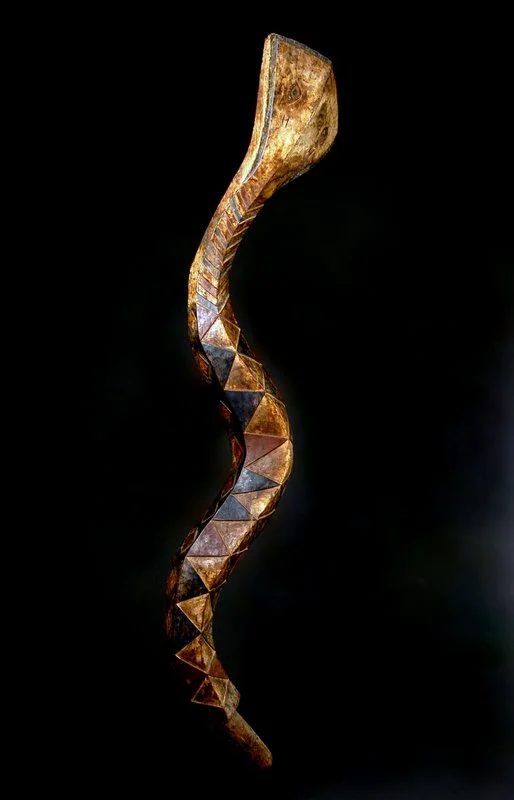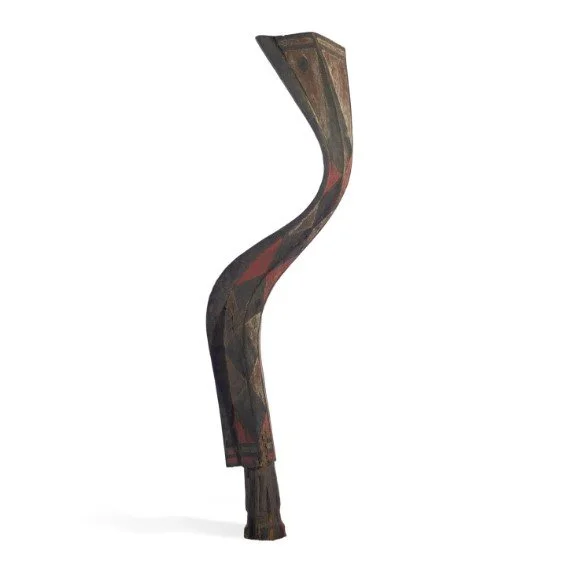Baga Serpent Figure
Baga Serpent Figure (Bansonyi)
Guinea
Early 20th century
Wood. Height: 91 in.
Price: $1,272,000
Description
The Baga peoples are an ethnic group originally spread along the coasts of Guinea in small villages comprised of several clans or families. Particularly in areas around modern cities like Conakry and Boke, the Baga are ethnically diluted, and at least since the beginning of the twentieth century, outside influences have repressed and deformed original tribal practices. The coast of Guinea is a maze of swamps and lowlands which seem to have insulated the Baga from the earliest predations of colonialism; but their deeper cultural history puts their origins in the highlands of the Guinea interior from which they made an exodus, possibly in the 16th century, under pressure from other, better-armed groups. From these various pressures sprang a rich and varied spiritual/artistic vocabulary which remains intact into the present.[1]
The serpent figure is the Baga people’s most powerful extant ritual deity.[2] Identified as an a-Mantsho-na-Tshol by Lamp, these frightening water or snake spirit manifestations appear at a distance from village observers and then depart after conducting their ceremonial function. Often referred to as a headdress, (but possibly held by an “armature” with its base at waist or shoulder level and grasped in the arms of its carrier), the lower part of the figure is surrounded by a tent of geometrically woven material and a reed skirt to conceal the dancer beneath. Many accounts refer to the initiation and circumcision of boys, but usage and ritual meaning differ from region to region.[3]
The ceremony has never been reliably observed by an outsider, however, and its meanings are variable and remain ambiguous.[4] One interpretation states: “Two bansonyi make their appearance among the Baga Fore during the boys’ initiation festival; they are decorated with streamers and are supported by a scaffolding carried by several men hidden under palm leaves and pieces of cloth. Representing “husband” and “wife”, the protective spirits of each half of the village, the bansonyi fight a duel (though its outcome will not affect the necessary unity of the community). After signaling the opening of the festival, the spirits disappear into the sacred grove.”[5]
Our example stands at 91 inches tall and exhibits an “extremely rare double undulation.”[6] Well-defined triangles ascend the body in alternating black, red, and white, transforming at the neck into narrow inverted chevrons. The figure culminates in a broad wedge-shaped head with a dramatic black border. The eyes and two small scarifications are incised on either side of a central nasal bridge which extends up from the body. The length of the body evokes a heavily-muscled serpent, sculpted smoothly into flowing vertical surfaces, almost tactile in their evocation of an organic being. Richly incised overall, it has a very even patina with some wear visible in the white fields on the lower surface of the central bulge, (see notes.) This is a classic basonyi form, and a beautiful example combining the surface, ornamentation, and sensitivity of execution which are the hallmarks of an extraordinary artist.
Footnotes
[1] Lamp, Frederick. Art of the Baga: A Drama of Cultural Reinvention (New York: Prestel, 1996). 49.
[2] Lamp, Art of the Baga, 76.
[3] Lamp, Art of the Baga, 80-83.
[4] Phillips, Tom, ed. Africa : The Art of a Continent. London: Prestel, 1996. 476.
[5] Schmalenbach, Werner, ed. African Art: From the Barbier-Mueller Collection. Munich: Prestel, 1988. 101.
[6] Lamp, Art of the Baga, 53.
Sotheby’s
A Magnificent and Highly Important Baga Serpent
Republic of Guinea
African, Oceanic, and Pre Columbian Art: Live Auction N08444 16 May 2008, New York. Lot 130.
Auction Estimate: 1,500,000 - 2,000,000 USD
Price Realized: 3,289,000 USD
Highest Realized Price
Highest Single African Art Piece Sold at Auction, Spring 2008See "Art in Motion: Top Sellers at Auction: Spring 2008” Tribal Art: Quarterly Journal of the Art Culture and History of Traditional Peoples and New World Civilizations 12 (4), no. 49 (Summer 2008): 36.
(Photo: Sotheby's)
Christie's
Serpent Baga, Bansonyi
Republic of Guinea
Art Africain et Océanien: Live Auction 3553 19 June 2013, Paris. Lot 58.
Auction Estimate: 800,000 - 1,200,000 EUR
Price Realized: 2,337,500 EUR
(Photo: Christie's)
Baga. a-Mantsho-ña-Tshol.
Guinea.
19th or 20th century
Wood, painted red-white and black.
Foundation Beyeler, Switzerland.
(Photo: Foundation Beyeler)
Headdress: Serpent (a-Mantsho-ña-Tshol)
Guinea
19th-20th century
Wood, pigment.
The Metropolitan Museum of Art.
(Photo: The Metropolitan Museum of Art)
Serpent Headdress (a-Mantsho-ña-Tshol). Baga.
Guinea.
19th-20th century
Wood, pigment.
The Metropolitan Museum of Art.
(Photo: The Metropolitan Museum of Art)
Provenance
Collected by Baba Keita, Abidjan, Ivory Coast, before 1958. Sold to our collector in 2003, Sarasota, FL.
From a collection of Baga pieces collected by Baba Keita before 1958 and held in storage by him and later by his brother, Adama Keita, until 2003 in Guinea. Extensive documentation of the collection purchase and transfer can be seen here.
Lamp, Frederick. Art of the Baga: A Drama of Cultural Reinvention. New York: Prestel, 1996.
Martínez-Jacquet, Elena. “So Familiar, so Mysterious: The Art of the Baga of Guinea at the Musée Barbier-Mueller in Geneva.” Tribal Art: Quarterly Journal of the Art Culture and History of Traditional Peoples and New World Civilizations 18 (1), no. 70 (Winter 2013): 68–71.
Petridis, Constantine. “Not Just a Snake: New Light on the Serpent Headdress at the Cleveland Museum of Art.” Tribal Art: Quarterly Journal of the Art Culture and History of Traditional Peoples and New World Civilizations 21 (1), no. 82 (Winter 2016): 122–27.
Phillips, Tom, ed. Africa : The Art of a Continent. London: Prestel, 1996.
Robbins, Warren M., and Nancy Ingram Nooter. African Art in American Collections. Washington and London: Smithsonian Institution Press, 1989.
Schädler, Karl-Ferdinand. Encyclopedia of African Art and Culture. Munich: Panterra, 2009.
Schmalenbach, Werner, ed. African Art: From the Barbier-Mueller Collection. Munich: Prestel, 1988.
Visona, Monica Blackmun, Robin Poynor, Herbert M. Cole, Michael D. Harris, Rowland Abiodun, and Suzanne Preston Blier. A History of Art in Africa. New York: Prentice Hall/Harry N. Abrams, 2000.





